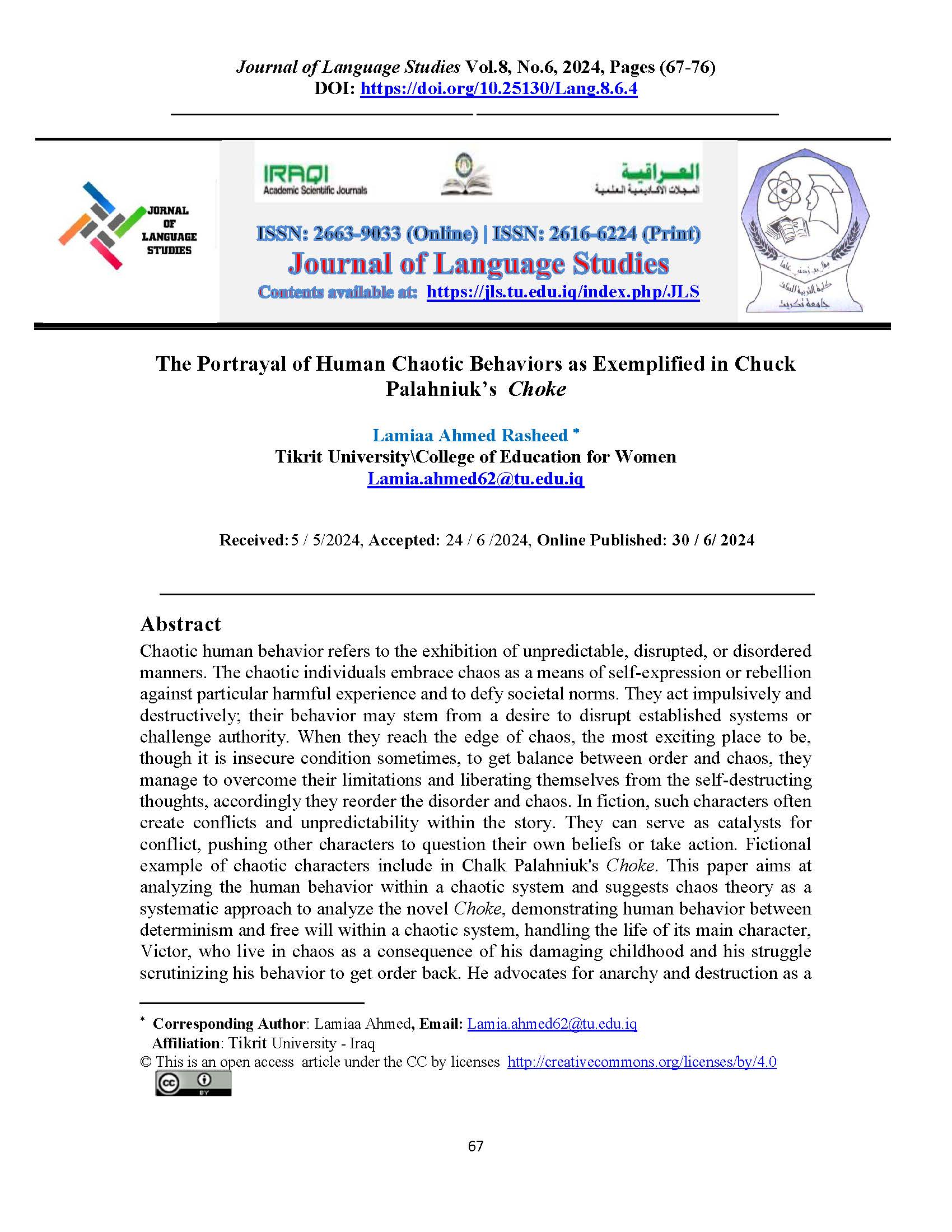The Portrayal of Human Chaotic Behaviors as Exemplified in Chuck Palahniuk’s Choke
DOI:
https://doi.org/10.25130/Lang.8.6.4Keywords:
Chaos Theory, determinism, free will, Palahniuk, and ChokeAbstract
Chaotic human behavior refers to the exhibition of unpredictable, disrupted, or disordered manners. The chaotic individuals embrace chaos as a means of self-expression or rebellion against particular harmful experience and to defy societal norms. They act impulsively and destructively; their behavior may stem from a desire to disrupt established systems or challenge authority. When they reach the edge of chaos, the most exciting place to be, though it is insecure condition sometimes, to get balance between order and chaos, they manage to overcome their limitations and liberating themselves from the self-destructing thoughts, accordingly they reorder the disorder and chaos. In fiction, such characters often create conflicts and unpredictability within the story. They can serve as catalysts for conflict, pushing other characters to question their own beliefs or take action. Fictional example of chaotic characters include in Chalk Palahniuk's Choke. This paper aims at analyzing the human behavior within a chaotic system and suggests chaos theory as a systematic approach to analyze the novel Choke, demonstrating human behavior between determinism and free will within a chaotic system, handling the life of its main character, Victor, who live in chaos as a consequence of his damaging childhood and his struggle scrutinizing his behavior to get order back. He advocates for anarchy and destruction as a means of personal liberation, whose violent and antisocial behavior challenges the boundaries of morality. This novel serves as catalysts for chaos and reordering the disorder. To attain this aim, the study adapts chaos theory as an approach of analyzing this topic in Choke. At the end when he reached the maximum of chaos, he gets the balance between order and chaos liberating himself from his self-destructive thoughts. He owns eventually a free will to change his destiny and find out new paths of happiness and self-organization.
References
Aman,Yasser (2007). Chaos Theory and Literature from an Existentialist Perspective. CLC Comparative Literature and Culture. September.
Bishop, Robert C (2011). Chaos, Indeterminism, and Free Will. Illinois.
Biswas, Hena Rani, & Md.Maruf Hasan (2018). Chaos theory and its Applications in our Real Life. Barishal University Journal Part 1,5 (1&2), p. 123-140.
Justin, Mibaile (2019). Chaos in Human Brain Phase Transition. Research Advances in Chaos Theory. Ed. Paul Bracken. https://www.intechopen.com/chapters/68375.
Libet, Benjamin(1985). "Unconscious Cerebral Initiative and the Role of Conscious Will in Voluntary Action.'' The Behavioral and Brain Sciences 8, 529-567.
Mart Çağrı Tuğrul (2013). “Choke” Chuck Palahniuk Book Review.
Advances in Literary Study 01(02):16-18
DOI:10.4236/als.2013.12005
Navario,Jose & Carlos Arrieta (2010). Chaos in human behavior. The Spanish journal of psychology .Vol.13,No.1. pp 244-256.
Palahniuk, C. (2008). Choke. New York, Anchor.
Rasmussen, P. A. (2005). Personality-guided: Cognitive Behavioral Therapy.
American Psychological Association.
Till, Gregory J., (1992). A chaotic approach to free will and determinism.
Presidential Scholars Theses (1990 – 2006). 147.
https://journals.sagepub.com/doi/full/10.1177/2158244017725130.

Downloads
Published
Versions
- 2024-06-30 (2)
- 2024-06-30 (1)
